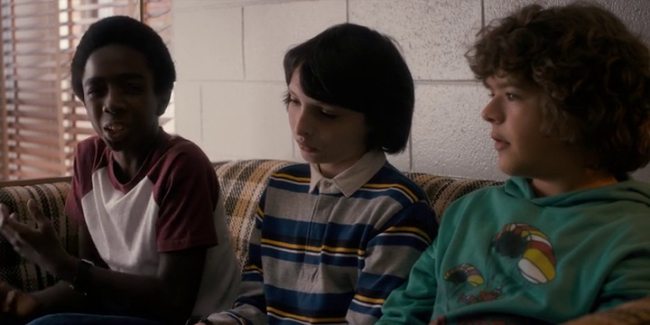
Contemplating the lack of a new Twin Peaks to-night, I finally started watching Stranger Things a few days ago. Two episodes in I'm enjoying it, though I feel like Scottie in Vertigo when he keeps thinking he's spotted Madeleine only for it to just be a woman who looks like her because the massive Twin Peaks influence I see at work in Stranger Things made me jonse for the original even more. But, I realised, that's not fair, Stranger Things draws from a lot of other influences, too, to create its own virtues.

I'm sure all the stylistic echoes from 80s films have been picked over plenty by now--the John Carpenter-ish synthesiser soundtrack, the general ode to 80s kids domestic adventure movies like E.T. and Gremlins, the fact that Natalia Dyer looks like Mia Sara.

I love her outfits, too, and their recollection of a time when women chose clothing that stood in low contrast to their skin.

This compliments the wonderful, shadowy visual style that recollects a time when filmmakers really liked to show darkness in movies, though the lighting on Stranger Things still has the modern care to keep everyone's facial expressions visible most of the time. It's the look that more than anything else made me feel like I wanted to be a kid again. Though the kids on this show are slightly older than me--I was born in 1979, the show takes place in 1983. But I remember how pervasive this type of film was, so much that I remember really looking forward to being twelve years old because so many movies were making it seem like a great time to be alive.

From Twin Peaks, the show takes the concept of a small town reacting to the loss of a child with an emphasis on how marvellous it is, even as it's sad, that an entire town takes notice of and can grieve for the loss of one person. The announcement for an assembly being held at the high school for the missing child, Will, recalls the principal's announcement in the Twin Peaks pilot. The creators of Stranger Things, the Duffer Brothers, had previously worked on Wayward Pines, a show that was unabashedly modelled on Twin Peaks, so I wonder if all the Twin Peaks echoes on Stranger Things were intentional or if the Duffer's heads had just been so in the Twin Peaks thought space for so long. Winona Ryder as Will's mother, Joyce, calling around to find out where Will was also couldn't fail to remind me of Sarah Palmer.

I think this might be the best Winona Ryder performance I've seen. Francis Ford Coppola's version of Dracula is one of my favourite movies but I understood the ruefulness with which he comments, on the DVD commentary, on how Ryder had told him she'd already basically done most of her scenes in Edward Scissorhands. Her portrayal of Joyce in Stranger Things is the most engaged I've seen her be with a role, I get the sense that she's fighting tooth and nail to prove she can do it.

I like the kids, the lead characters on the show. I like how they were cast to recall 80s casting trends. All of them seem to have big lips and excess saliva. They're not exactly like 80s movie kids; they're not as cruel, for one thing. Dustin (Gaten Matarazzo) being forced to stretch his arms by a couple bullies doesn't have the nervous and discomforting quality of Chunk in Goonies pressured to shake his large belly by his friends. But who would have the creative clout besides David Lynch to do something that extreme now? And should it be done? I'm not sure myself, partly because I remember not liking Goonies, the main reason I haven't watched it since the 80s. I probably ought to revisit it.
I will say that in contemplating the value of the show's nostalgia I got to thinking about the value of nostalgia filmmaking/tv making. I think Stranger Things might rise to being more than a collection of stylistic callbacks eventually but I would like to see some of its choices simply taken as good for themselves, regardless of the reason for they're being there, like the darker visual style.

No comments:
Post a Comment